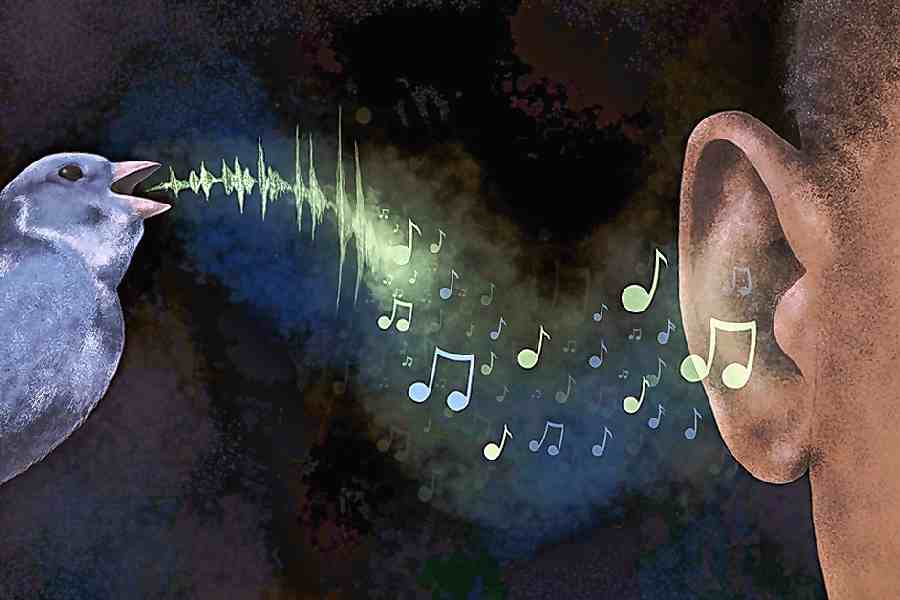Existing research points to one main conclusion: birdsong is structured like human music. Songbirds change their tempo (speed), pitch (how high or low they sing) and timbre (tone) to sing tunes that have specific rules and resemble our own melodies.
Other features, like cadence and tension, are also used in both birdsong and human music, said Tina Roeske, a behavioural neurobiologist who specialises in birdsong. Just as the familiar tune In the Hall of the Mountain King gradually builds speed — “accelerando”, as the compositional notation is known — some birdsong does too, like that of the nightingale.
While earlier studies focussed on syntax, or how notes were ordered, newer research is integrating rhythm, too, by analysing how notes are timed. In human music, rhythm is often thought of as a constant beat, like the one that opens We Will Rock You by Queen. But in birdsong, rhythm refers to patterns of notes, regardless of whether they are repeated or not.
To humans, birdsong may appear to have “a random structure”, Roeske said. Because of the speed at which birds sing — up to four times as fast as most human music — that rhythm is “hard for us to grasp and appreciate”, she added.
Roeske and her co-author, Ofer Tchernichovski, a zoologist and psychologist at the City University of New York in the US, researched birds’ musical structure and found that birdsong rhythms fell into three general categories: isochronous, in which intervals between notes are equidistant; alternating, in which a note is longer than the previous one; and ornament, an exaggerated form of the alternating pattern. Human music contains these rhythmic patterns, too.
Other researchers are also gaining insights by focussing on birdsong rhythm.
“We found that rhythm and syntax have a relationship that nobody has really thought about before,” said Jeffrey Xing, a graduate student in psychology at the University of California, San Diego, US, and an author of a September 2022 paper analysing the song structure of the Australian pied butcherbird.
Pied butcherbirds “seem to prefer some song rhythms over others”, such as isochronous rhythm, Xing said. In some ways, these rhythmic patterns follow rules like forms of poetry that have strict meter. A good example is a sonnet.
“It’s a very rigid rhythmic structure that you have to follow and, somehow, the syntax of the words that you use has to conform to that,” he said.
Hollis Taylor has dedicated her life’s work as a violinist and ornithologist to the pied butcherbird, a species she deems a fellow musician.
Taylor, who analysed the bird’s rhythmic structures with Xing, records the birds’ songs in Australian deserts and savannas in the middle of the night. Then, she transcribes their notes into musical notation.
“The musician in me recognises the musician in them,” Taylor said. She has observed what appear to be warm-up sessions, rehearsals and singing contests. Other than humans, there’s only a “small club” of species with an observed capacity to learn songs and vocal patterns, Taylor said, including songbirds, parrots, hummingbirds, bats, elephants and some marine mammals.
Neuroscience research points to the idea that this affinity between birds and humans is not so unusual. In terms of musical ability, we are more like birds than we are like our primate cousins or other mammals, said Johan Bolhuis, a zoologist who specialises in the cognitive neurobiology of birds and humans.
Our brains and songbirds’ brains have a similar way of learning musicality. But the brains of monkeys and non-songbirds, such as gulls, are organised in a different way, Bolhuis said. It could be a sign of shared creative abilities: just like humans, some songbird species seem to improvise based on the song patterns that they have learned.
But there’s no evidence that their songs have meaning, Bolhuis said.
“In the mind of the great composers, they actually meant something” with music, he said. “It’s not so much the case in birdsong.”
Also, birds have a limited repertoire, whereas with only a limited number of items, the human mind “can be infinitely creative”, Bolhuis point out.
Researchers agree, however, that birdsong can communicate identity. “They can recognise individuals just the way you and I can recognise each other by our voices,” said Mike Webster, director of the Macaulay Library at the Cornell Lab of Ornithology in the US.
When birds from a certain area hear a familiar bird singing, he explained, it’s no big deal. But if the same bird moves to a new area, the birds there “go bananas” in a territorial uproar. In this sense, singing is like a way for birds to identify themselves — but there may be more to it than that.
While scientists have studied birdsong for decades, they know little about why and how birds select specific tunes and what counts as deliberate communication versus meaningless song.
Through brain-imaging studies, neuroscientists have found that the human brain responds to music most strongly along a particular neural circuit that is activated when a person listens to a song perceived as pleasant. Studies have shown that birdsong elicits the same response in female birds, possibly as an evolutionary mechanism for mate attraction. But scientists still wonder whether birds sing for entertainment in addition to mating.











